The best headphones for running in 2024, tried and tested
Content is created by CNN Underscored’s team of editors who work independently from the CNN newsroom. When you buy through links on our site, CNN and its syndication partners may earn a commission. Learn more
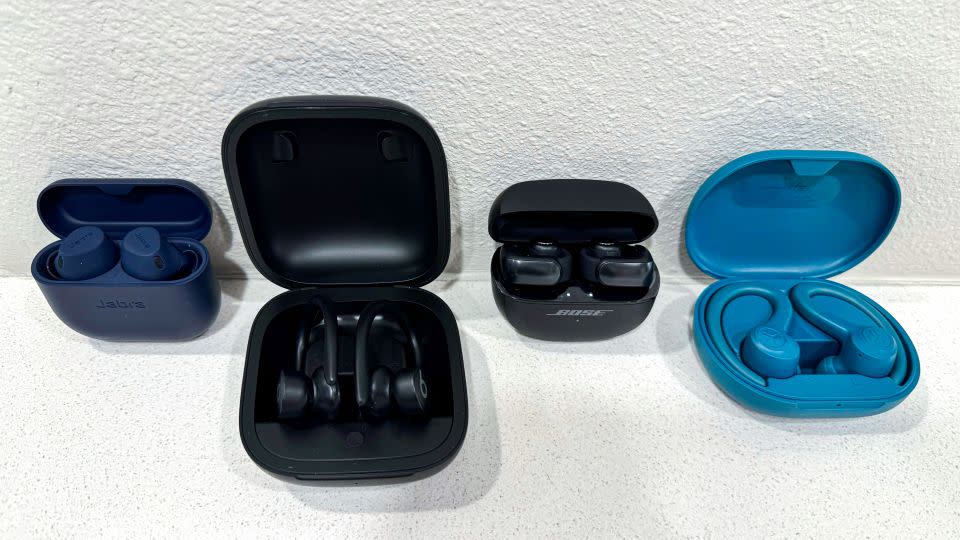
Running is better with music: Blasting songs that pump you up as you get ready actually makes you more excited for your workout, according to research published in The Journal of Strength and Conditioning Research. In fact, upbeat music improved performance when runners felt tired in a 2021 study published in the Journal of Human Sport and Exercise, and listening to music also led to quicker post-run recovery, according to a 2019 study from the Memorial University of Newfoundland in Canada.
The workout boost makes running headphones an essential piece of gear for (most) runners. But there’s a lot to consider before committing to a pair: Do you prefer earbuds with an attachment that hooks over the ear or earbuds that sit in the ear? Do you want true wireless earbuds or headphones that are attached so you can take one out or off without losing it? Do you want to be totally immersed in sound, or do you still want to be able to hear what’s going on around you? We did the work for you, putting the latest and most popular running headphones to the test over hundreds of miles. Here are the top four we recommend.
Jabra Elite 8 Active
Best running earbuds
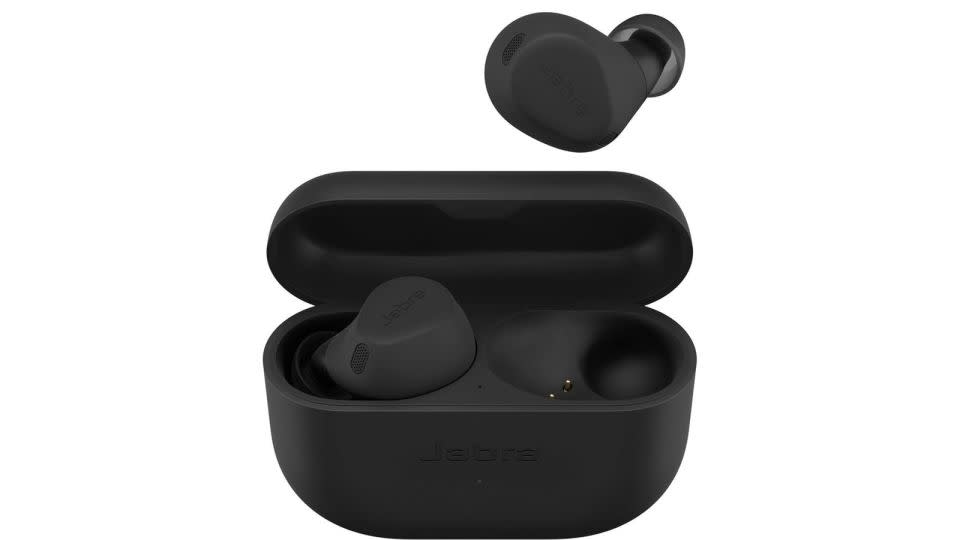
Built to be tougher than your most intense workout, these earbuds can handle the gnarliest trails and the worst weather while offering a best-in-class fit that won’t budge when you pick up the pace.
$180 at Amazon
$180 at Best Buy
$180 at Jabra
Beats Powerbeats Pro
Best over-the-ear running headphones
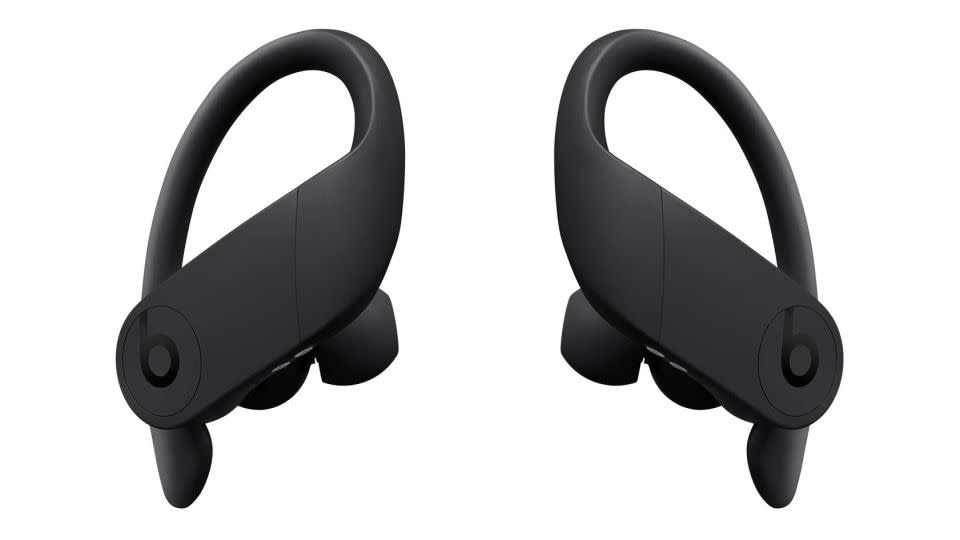
A sleek, customizable design keeps these comfortably anchored in place no matter how many miles you’re running, and the battery life will outlast even your longest workouts.
Bose Ultra Open Earbuds
Best open-ear running headphones
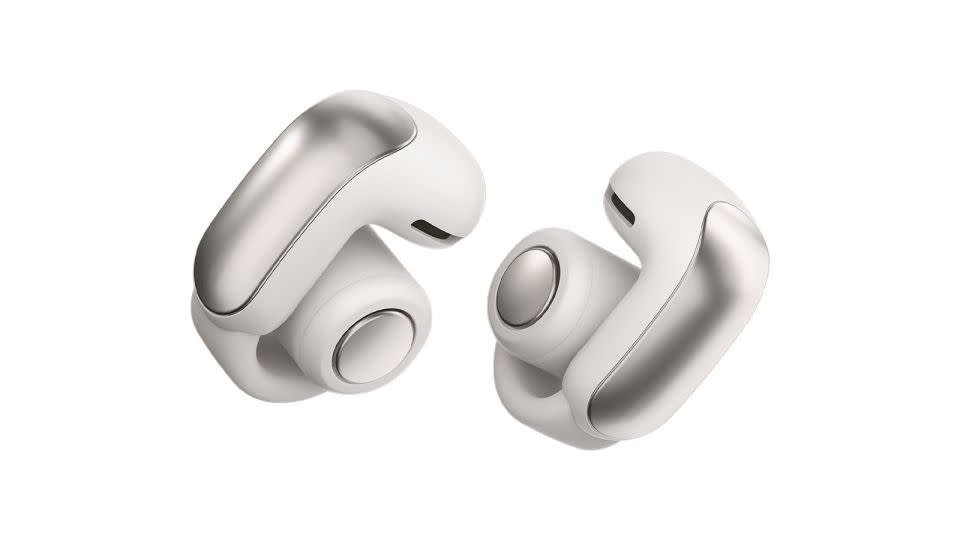
With a cuff-like fit that doesn’t budge, over seven hours of battery life and the exceptional sound quality you’d expect from a Bose product, you can’t beat these open-ear headphones, even with the high price tag.
JLab Go Air Sport
Best budget running headphones
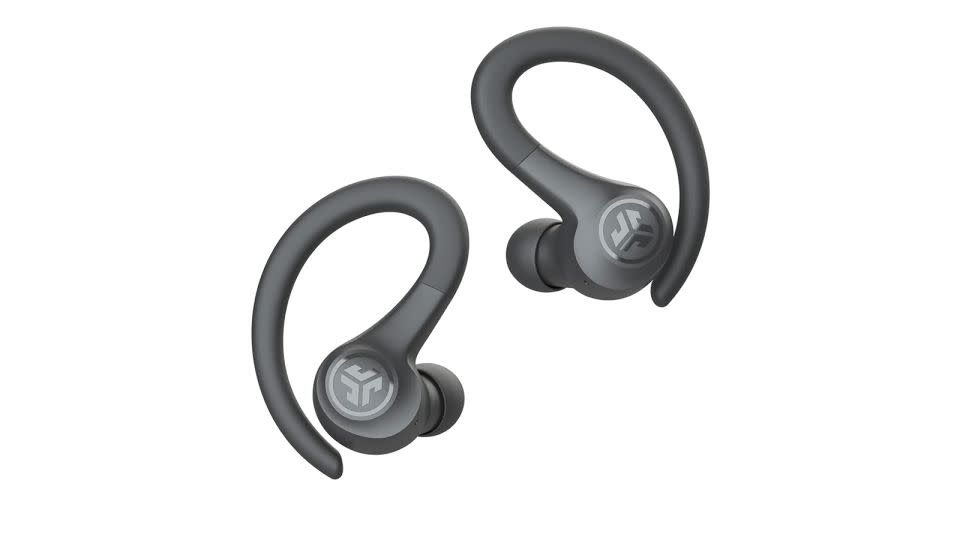
In this compact design, JLab delivers features — including sound quality, battery life and durability — on par with more high-end headphone models for a fraction of the price.
Best running earbuds: Jabra Elite 8 Active
$200 $180 at Amazon, Best Buy and Jabra
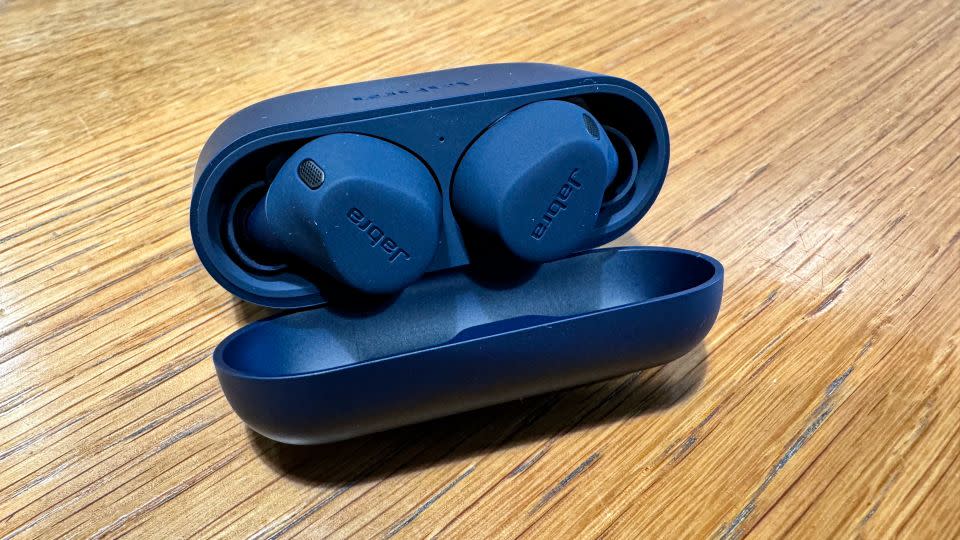
Earbuds can be tough because no matter how many silicone ear tips a company sends to help properly seal your ear canal, the size of the speaker compartment isn’t adjustable and can cause discomfort if it’s not the right fit for your unique ear shape. The Jabra Elite 8 Active earbuds are a little smaller than most of the other true earbuds we tried, and that made all the difference. Despite their smaller size, Jabra’s liquid silicone rubber compound felt super smooth against the skin and kept the buds from budging, even during my fastest speed workouts.
Part of what allows for the size is the smaller drivers (the part of the headphones that converts electrical signals into sound). Eight to 15 millimeters is standard in most earbuds, and the drivers in the Jabra Elite 8 Active earbuds are just 6 millimeters, one of the smallest of the headphones we tested. Fortunately, that doesn’t compromise the sound. These earbuds offer spatial audio, six music presets and a customizable music equalizer. You can also switch between Active Noise Cancellation and HearThrough (Jabra’s Transparency mode). As you’d expect in active headphones, these emphasize the bass without compromising the rest of the sound. I actually preferred running without the spatial audio activated because it ended up taking some of the clarity out of the music.
Of course, battery life is hugely important when you’re logging lots of miles in a pair of headphones. The Elite 8 Active boasts a battery life of up to eight hours with ANC turned on and 14 hours with it turned off. A mere five-minute charge will give you up to another hour of juice too. The case is one of the smallest of the headphones we tested, which means you could potentially run with it if you really needed to.
Runners who often find themselves in extreme conditions will appreciate the amount of testing that went into constructing the Elite 8 Active. These are billed as “the world’s toughest earbuds,” as they can withstand clouds of dust and be fully submerged in up to 1.5 meters of water. If you’re someone who runs on trails or won’t be stopped by inclement weather (I wore these through a March blizzard in Denver), this is the type of earbud you’ll want with you.
Best over-the-ear running headphones: Beats Powerbeats Pro
$200 at Best Buy; $250 $200 at Amazon; or $250 at Apple
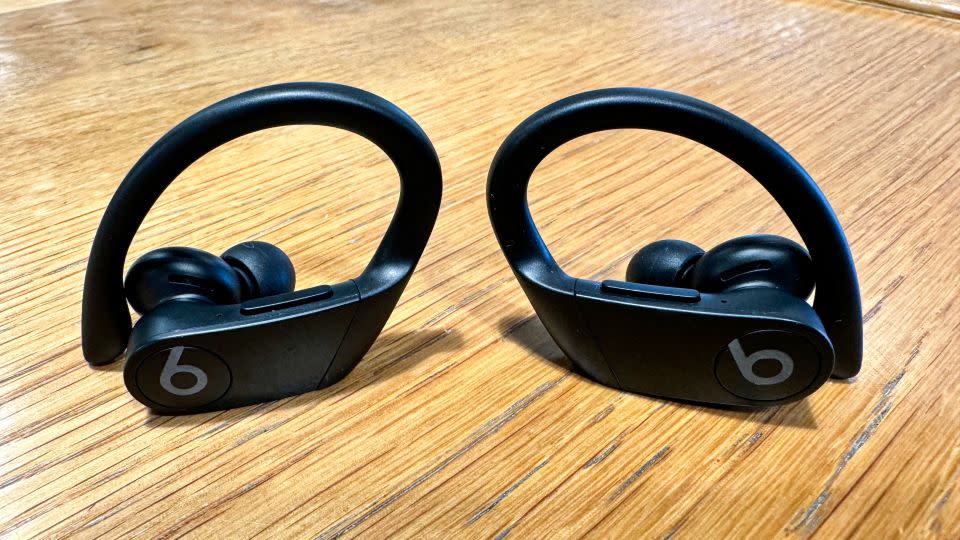
I’ve run 12 marathons in different versions of the Beats Powerbeats Pro. The main reason I trust these headphones for distance running: They last for up to nine hours on a single charge. That means I don’t have to bring the charging case (which provides 24-plus hours of juice) to the start line with me on a big race day, and I can trust the headphones to play all the way until I cross the finish line. Plus, if you’re not wearing the earbuds, they’ll go into idle mode to conserve power, even without the case.
The Powerbeats Pro are fully wireless earbuds that hook over the ear, anchoring them in place while you’re in motion. The hook is flexible and adjustable (I prefer them to be a little looser so they don’t rub at the back of my ear during long-time wear), and I found the rubberlike material to be a little sleeker and softer than those on other earbuds I tested. I tend to opt for over-the-ear headphones instead of earbuds during races and longer runs because the hooks give me the option of popping an earbud out of my ear canal so I can hear my surroundings or have a conversation with another runner if I want to. I’ve even taken an earbud out and hooked it onto my sports bra — and I haven’t lost one yet.
These earbuds are powered by Apple’s proprietary H1 chip, the same one found in AirPods, but the Beats offer significantly better sound. Previous Beats products have been extremely heavy on the bass, and that’s toned down here in a good way. Overall, the sound is clear and rich but with plenty of power to motivate your workouts. Picky listeners may miss the lack of modes and customization, and these aren’t noise-canceling headphones, but when it comes to using these on the run, all this is outweighed by the long-lasting battery life, functionality and sound quality.
Best open-ear running headphones: Bose Ultra Open Earbuds
$299 at Amazon, Bose and Best Buy
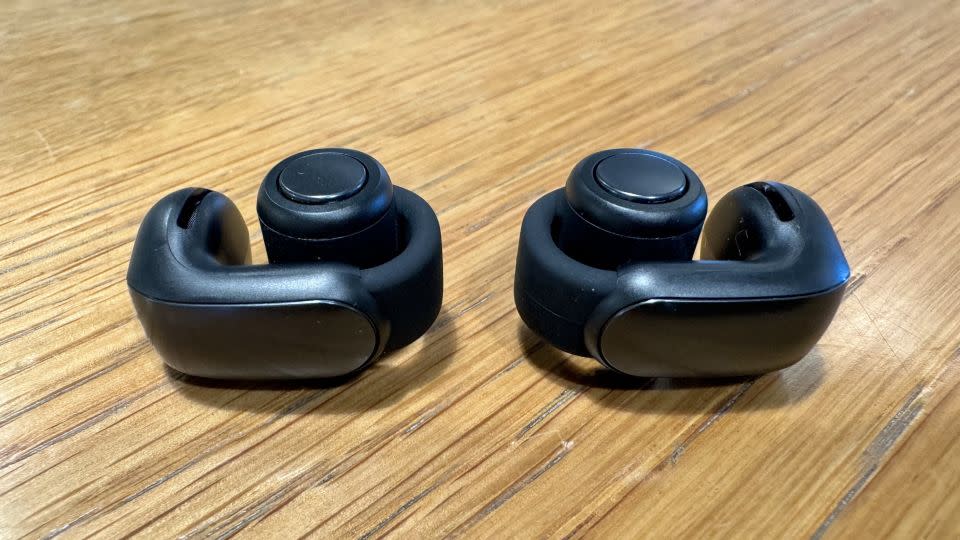
If I had to pick a “best overall” option for running headphones (which I did not because over-the-ear headphones and earbuds and open-ear headphones all offer very different experiences on the run), the Bose Ultra Open Earbuds would be a top contender.
Let’s start with the design. Instead of hooking over the ear, these act like a cuff, clipping on to the side of your ear and eliminating any discomfort. Seriously, I forgot I was wearing these (each earbud weighs just 0.22 ounces), and I wore them for a three-hour run and kept them on while hanging out afterward. They do look a little weird (I got a lot of questions from members of my run club), but the all-day wearability negates any fashion qualms.
And then there’s the Bose sound quality. Open-ear headphones use different kinds of technology, such as bone conduction and directional speakers, to enhance sound without plugging up your ears, but the listening experience can leave something to be desired. The Bose Ultra Open Earbuds use the same proprietary tech you’d find in the best Bose headphones: a 3D sound platform that really immerses you in audio (yes, that is possible with open-ear headphones!); Auto Volume, which adjusts your volume depending on your surroundings; and preconfigured custom modes, including a workout option that allows you to choose between Still and Motion modes. (I opted for Motion, in which the audio “follows” you, which is more ideal when you’re running.) I also really liked that I could assign shortcuts to the buttons on the barrel of each earbud. I set one to cycle through modes and one to activate the voice assistant on my phone so I never had to actually dig my phone out of my sports-bra pocket.
While I understand the value of open-ear headphones and the importance of being plugged into your surroundings, most options — including the super-popular Shokz headphones, which I’ve raced a marathon in — end up distracting me at some point in my longest runs. The Bose Ultra Open Earbuds manage to deliver superior sound without reminding me they’re there, and I found myself reaching for these more than any other headphones I tested. With up to seven and a half hours of playtime, you’ll find me wearing these in my next 26.2-mile race.
Best budget running headphones: JLab Go Air Sport
$30 From $24 at Amazon, $30 $27 at JLab or $30 at Best Buy
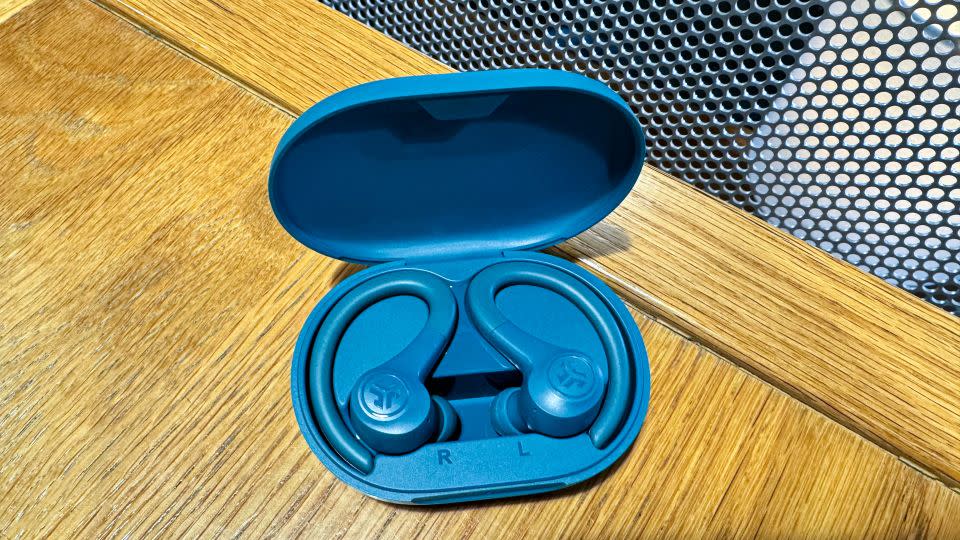
Good tech is expensive, but you don’t have to break the bank for a pair of headphones you’re going to sweat in and expose to the elements. Some of the latest budget-friendly running headphones are on par with pricier models in terms of battery life and sound quality, and the JLab Go Air Sport headphones are a great example.
Similar to the Beats Powerbeats Pro, these earbuds hook over the ear for stability, but they’re more compact than the other winged designs I tested. That made them a little less noticeable on the run, though there was less flexibility in the arms to adjust the fit. They’re made from plastic, so you’re not getting any kind of luxury feel here, but they’re durable and can stand up to the elements (and your own sweat), thanks to a solid sweat- and water-resistance rating.
Don’t write them off due to the low price and smaller size; you’re still getting a decent sound experience from these headphones. They have 8-millimeter dynamic drivers, which is on par with some higher-end headphones, and deliver enhanced bass as well as three preprogrammed EQs (Signature, Balanced and Bass Boost). It certainly doesn’t sound like a Bose product, but I was pleased enough with the audio, whether I was listening to old-school rock or Top-40 songs. (One thing to note: there is no Transparency mode.) You’re also getting eight-plus hours of playtime in each earbud.
Of course, a budget model is going to have some pain points. The biggest one for me was the on-device controls. In theory, single/multiple taps and holds allow you to control playback, call management, volume, digital assistance and EQ activation, but it was hard to get the device to recognize my touch. I found myself pressing the earbud into my ear (not ideal), and it would take multiple attempts to get the right command. But for $30, that’s not a deal breaker. I was perfectly happy with the out-of-the-box settings, and app support is coming soon.
What to consider when shopping for running headphones
Comfort
The gold standard for any piece of running gear, whether it’s apparel, shoes or tech, is that it won’t distract you from your run. Headphones should sit comfortably in the ears, without rubbing or adding pressure at the inner ear, outer ear or temples. Ideally, the headphones should come with silicone ear tips in multiple sizes so you can find the right fit, and adjustable ear hooks or wires that help secure them and avoid bouncing.
Sound
Though everyone is hoping for good sound quality, even if you’re listening to music to motivate your workouts, it’s important to keep in mind that workout headphones tend to prioritize bass. Most devices, however, allow you to choose from preprogrammed sound profiles or customize your own so you can get the most out of your listening experience.
Safety
Many headphones offer Transparency modes, which let outside sound in, and the open-ear headphone category has been growing significantly over the past few years, so there are now plenty of options to choose from that allow you to enjoy your music, podcasts or calls without totally blocking out the ambient noise around you. If you’re someone who regularly runs on the street or even on well-trafficked paths, sidewalks or trails, opt for a pair of headphones that gives you the option of tuning into what’s going on around you so you can stay safe.
Controls
For running, we recommend choosing headphones that have on-device controls that allow you to regulate the volume and playback, toggle between sound modes and answer calls without having to use your phone. The goal is always to keep moving, and you shouldn’t have to stop your run just to adjust something on your headphones.
How we tested
We tested 10 sets of highly recommended running headphones over the course of several hundred miles and two months. First, we polled the running community to see what headphones were most popular, then we combed through reviews to round out our list and checked with audio companies to make sure we had the latest releases. While running, we assessed not the sound quality but how secure the headphones felt while in motion, how safe we felt in our surroundings while wearing them, how comfortable they were as the hours went by and more. Our testing pool consisted of a mix of over-the-ear headphones, earbuds and open-ear headphones. Here is a comprehensive list of our testing categories.
Comfort
Fit: During runs, we assessed how well the earbuds fit in the ear canals, how secure the hooks felt around the outer ears and whether we experienced any pain or pressure in any area (with and without hats and/or sunglasses).
Feel: We considered how the materials felt against the skin: how textured it was, whether smooth parts gathered sweat and how heavy any parts were.
Size: In addition to noting the dimensions and weight of the headphones or earbuds, we paid attention to how light or bulky the design felt on the move as well as how big the speaker compartment was and how that felt in the ear.
Features
Water resistance: Because running works up a lot of sweat, we looked at the IP rating of each device, which indicates the degree of water protection. We also noted whether a company used additional technology to further protect the devices.
Controls: We noted how many and what type of control options were available on each pair of headphones, as well how easy those were to set up and use while in motion.
Battery life: We looked at how much playtime listeners get on a single change, how many more hours come from using the charging case and how much additional time you can add via a five- or 10-minute fast charge.
Sound
Modes: We looked at whether the headphones offered features like Active Noise Cancellation and Transparency modes, as well as spatial audio, fixed tracking and EQ presets to determine how listeners could customize their audio experience.
Speakers: We noted the size of the drivers, the number of mics and the different ways in which the design amplified sound waves.
Other running headphones we tested
Shokz OpenRun Pro
$180 at Amazon
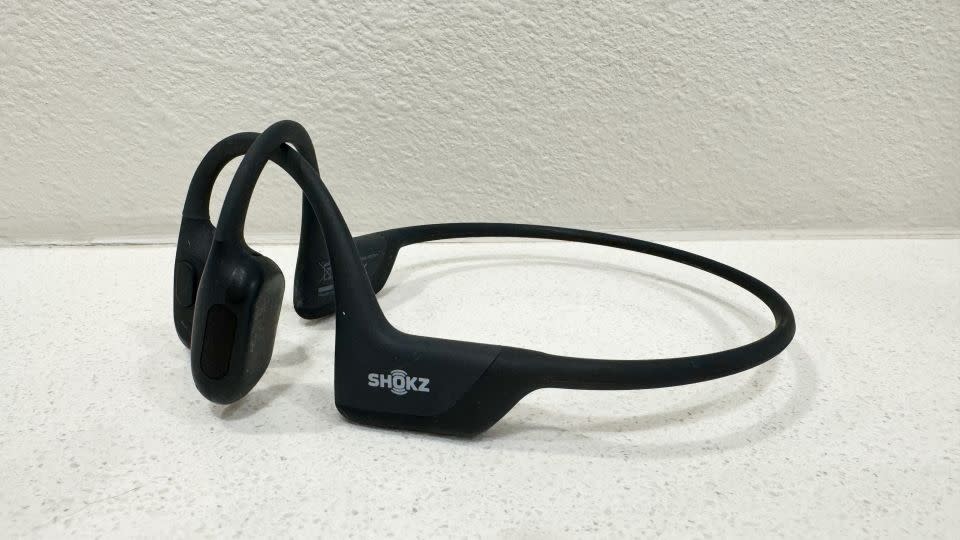
For a long time, Shokz seemed to have a chokehold on the running market. Their OpenRun Pro headphones hook around your ear, conducting sound through your cheekbone, bypassing the eardrum so you can clearly hear ambient noise. They’re very light — weighing in at just 29 grams — and have a springy titanium band that floats just above your nape. I wore these for an entire marathon (the battery lasts up to eight hours on a single charge) and didn’t experience any pressure points or bouncing. Bone-conduction headphones tend to put out a slightly tinnier audio quality, but two bass enhancers added to the cheekbone pads help pump up the sound.
Anker Soundcore AeroFit Pro Open-Ear Headphones
$170 at Amazon and Soundcore
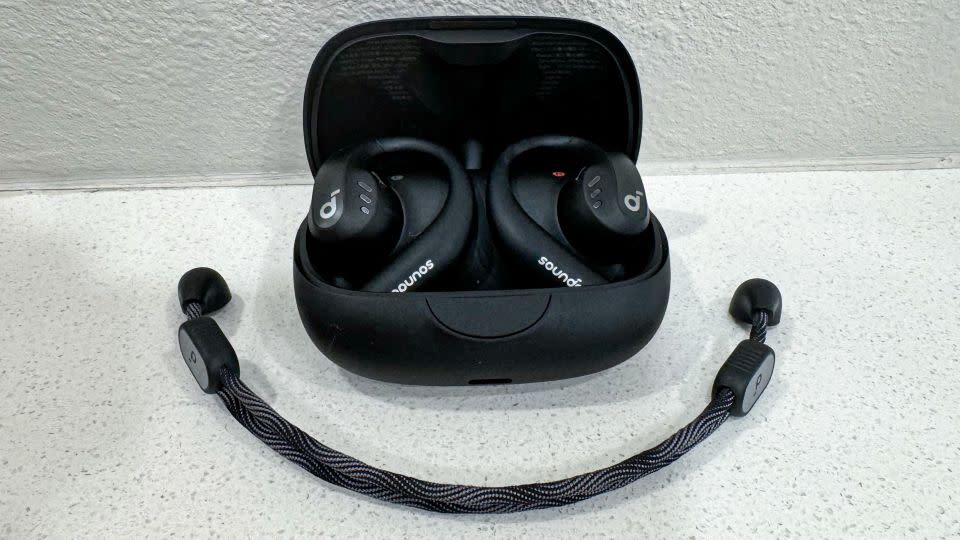
Another open-ear option, Anker Soundcore AeroFit Pro Open-Ear Headphones use a highly directional speaker to optimize sound quality, essentially reflecting more sound waves toward your ears. These are a little bulkier and a little more precarious during high-intensity runs, with the speaker, which sits near your ear canal, counterbalanced by the battery compartment, which sits behind your ear. (They come with a detachable 0.7-millimeter titanium wire neckband that clips on to each headphone, anchoring them in place). The larger speaker definitely offers a more immersive sound experience, though, with sound effects like spatial audio and sound field modes. The best part: The headphones last 14 hours on a single charge, and 10 minutes of fast-charging gives you a 5.5-hour boost.
Anker Soundcore Sport X10
$70 From $50 at Soundcore or $80 From $50 at Amazon
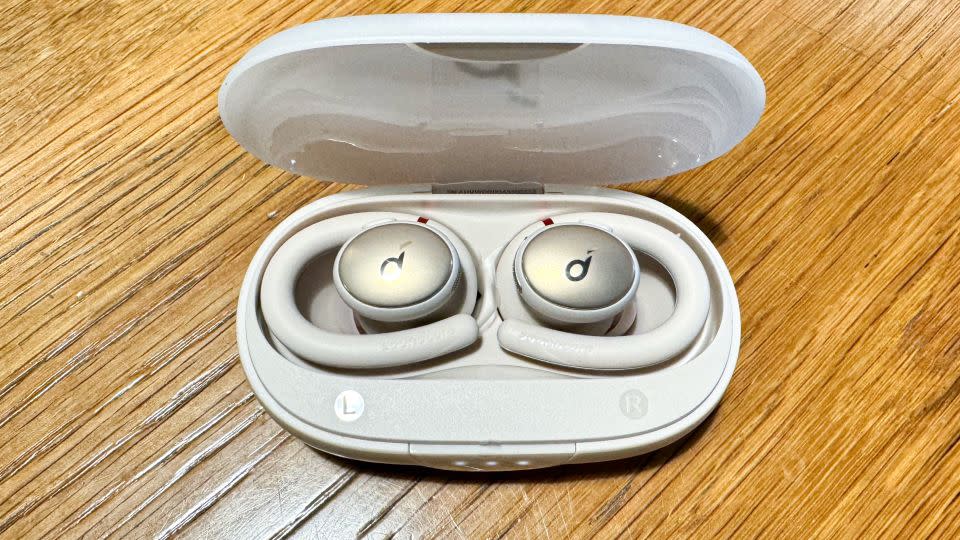
These are like a cross between over-the-ear headphones and earbuds. They have flexible ear hooks that rotate up to 210 degrees. Not only does that help you find the perfect fit but I found the hooks to be so unobtrusive I forgot they were there while providing a little extra stability on the run, especially compared to the open-ear version (they pair extremely well with sunglasses). If you’re all about that bass, you’ll love the dynamic acoustic system that’s boosted by Anker’s proprietary BassUp technology. I prefer listening to EDM during speed workouts, and my favorites sounded especially great on the Sport X10. They’re also great for heavy sweaters. In addition to being fully waterproof, they’re equipped with technology that keeps sweat from corroding all the important electrical parts.
Beats Fit Pro
$199 at Amazon or $200 at Apple
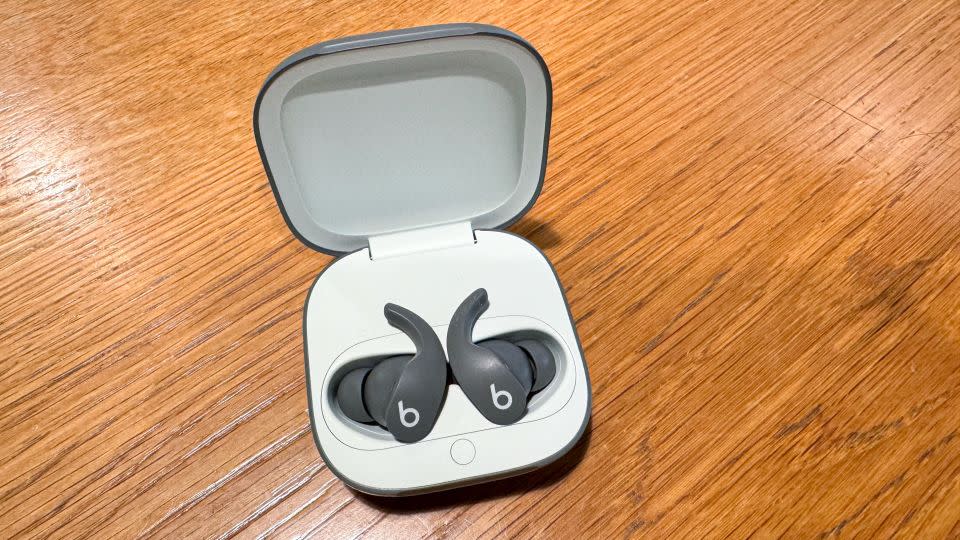
If you took the ear hook off the Beats Powerbeats Pro, you’d basically get the Beats Fit Pro. They run off the same chip, have the same water-resistance rating and share certain features, but Fit Pro buds have adaptive EQ, spatial audio and more, offering a more versatile listening experience and more powerful audio. I found the earbuds to fit a little more snugly in my ears, thanks to the combo of the silicone ear tips and flexible wingtips that keep them secure in the part of your ear shaped like a conch shell. As a result, my ears felt much more “plugged” than they did with the Powerbeats. If you want to go a step further in sealing yourself off from the world, adaptive Active Noise Cancellation calibrates audio in real time to minimize external sounds. If you want to be more dialed into your surroundings, just switch over to Transparency mode. These may be a better fit for gym goers than long-distance runners.
Apple AirPods Pro (2nd Gen)
$249 $200 at Amazon or $249 at Apple
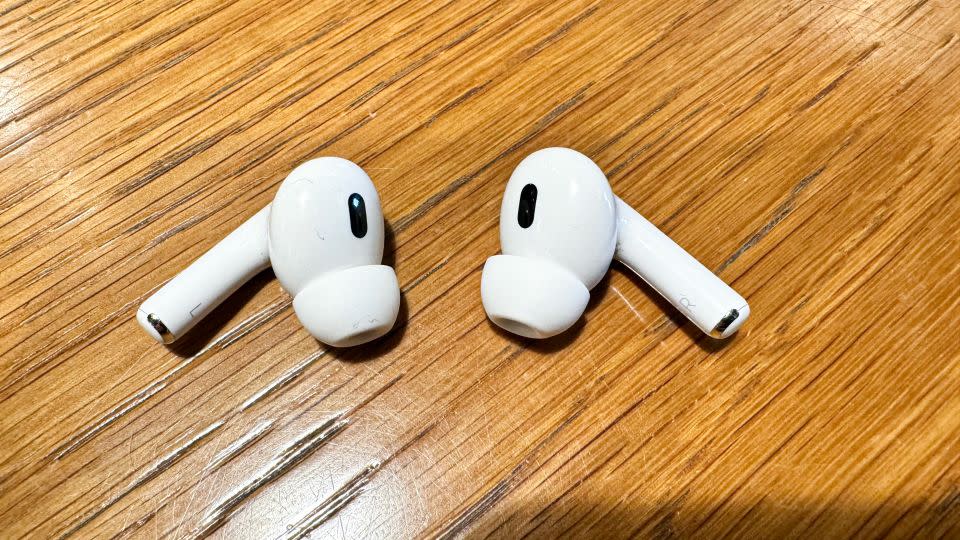
If you’re not sold on buying a pair of headphones solely for running, the Apple AirPods Pro 2 earbuds are a great option. In addition to using these at home, I’ve logged thousands of miles with them in my ears — and even though some runners say they have trouble keeping them in, I haven’t lost one yet. (I actually like that they don’t seal up my ear canal as much as some other earbuds.) In addition to excellent noise cancellation, you can easily turn on Transparency mode to stay safe on the street. Either way, the “personalized” sound quality is really crisp. The touch controls on each AirPod are also super simple to use on the run, so you don’t ever have to waste energy digging your phone out of your bra, belt or pocket.
Bose QuietComfort Ultra Earbuds
$299 at Bose, Amazon and Best Buy
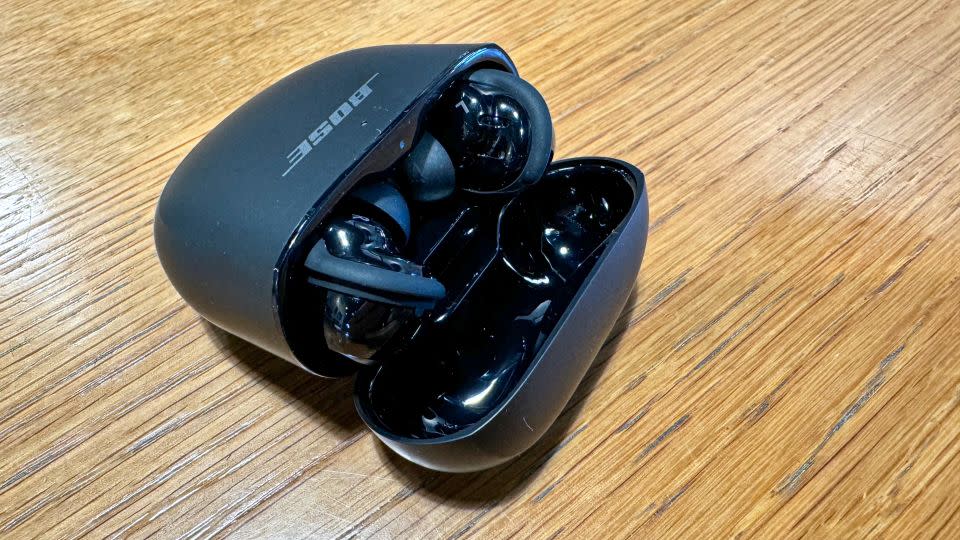
Bose’s earbuds were recommended by multiple runners; you can’t beat the brand’s sound quality. The QuietComfort Ultra are packed with tech like the brand’s award-winning acoustic noise cancellation and CustomTune audio calibration as well as Bose’s newest 3D sound format, Immersive Audio. With the volume all the way up, it felt like I was in the room with whatever band I was listening to. I also liked that I could adjust the volume and activate modes like Aware and Quiet by touching the buds without breaking my stride. The only drawback is that these feel a bit bulkier than some of the other earbuds I tested. I was always aware that my ears were plugged, and I’m not sure I’d be comfortable with that on longer runs.
JLab Epic Air Sport ANC
$99 $72 at Amazon or $100 $80 at JLab
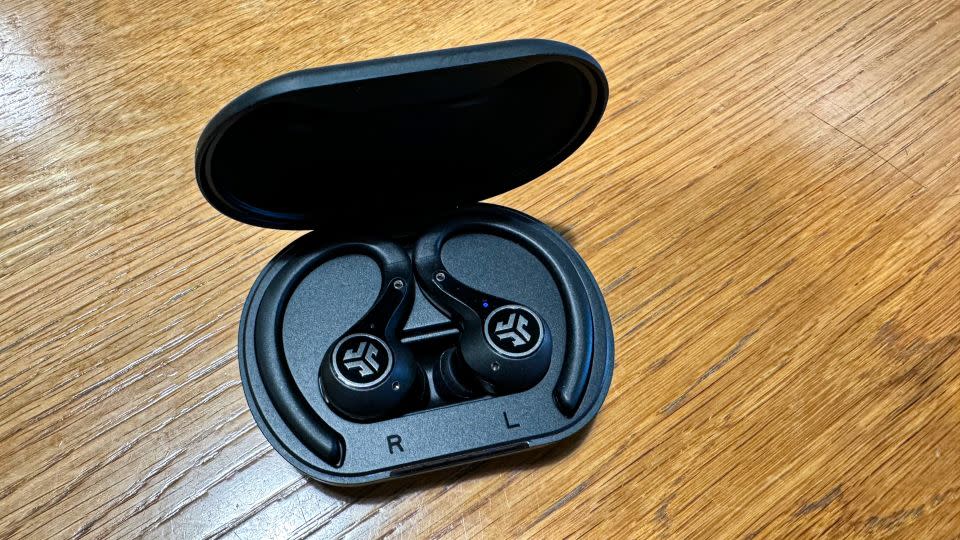
JLab is known for making affordable workout headphones (see my top budget pick, the JLab Go Air Sport), and the Epic Air Sport ANC is a more budget-friendly version of the Beats Powerbeats Pro. For less than $100, you get a similar over-the-ear design with multiple sets of ear tips to help you find the right fit, although the hooks are not adjustable. Touch controls let you toggle between modes, including noise cancellation and Be Aware modes, as well as three preprogrammed EQ settings and your own sound profiles. The sound quality isn’t quite as good as that of the Beats, but it’s perfectly adequate for working out, especially considering the long-lasting battery life: 11 hours with active noise cancellation on and 15 hours without it.
JBL Reflect Aero TWS
$150 $100 at JBL
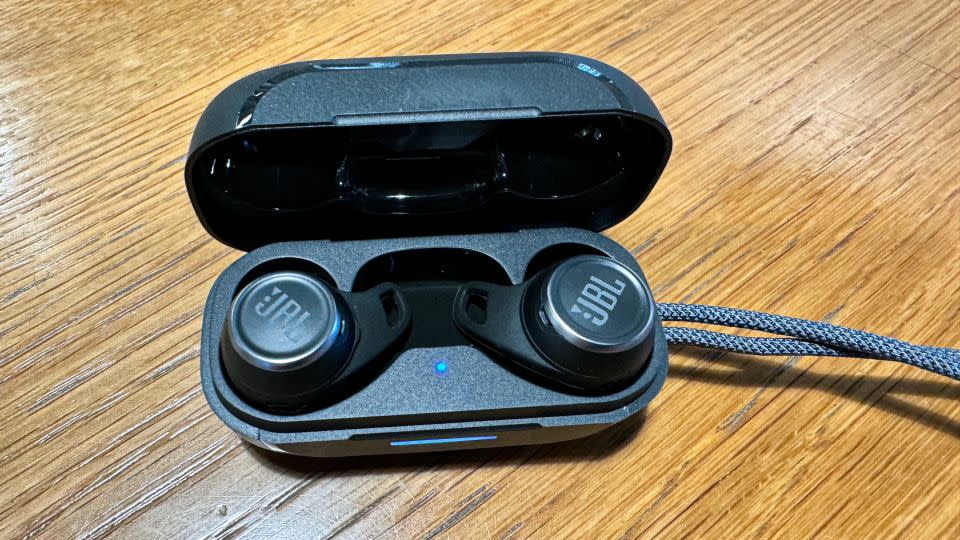
These JLB earbuds felt most similar to the Bose QuietComfort Ultra Earbuds. The bulky size of the buds put a lot of pressure on the insides of my ears, and I was hyper-aware of it the whole time I was running. (Obviously, everyone’s ear size is different, but I did not love that.) I was most impressed by these earbuds’ battery life: The maximum playtime is a whopping 24 hours, although that drops to seven or eight hours with ANC on. And the ANC is worth the loss of juice; these are equipped with noise-sensing mics that adjust to your surroundings in real time, and it was super easy to switch between that mode and Ambient Aware (or Transparency mode) by tapping a button on one of the buds.
JBL Endurance Peak 3
$100 $80 at JBL
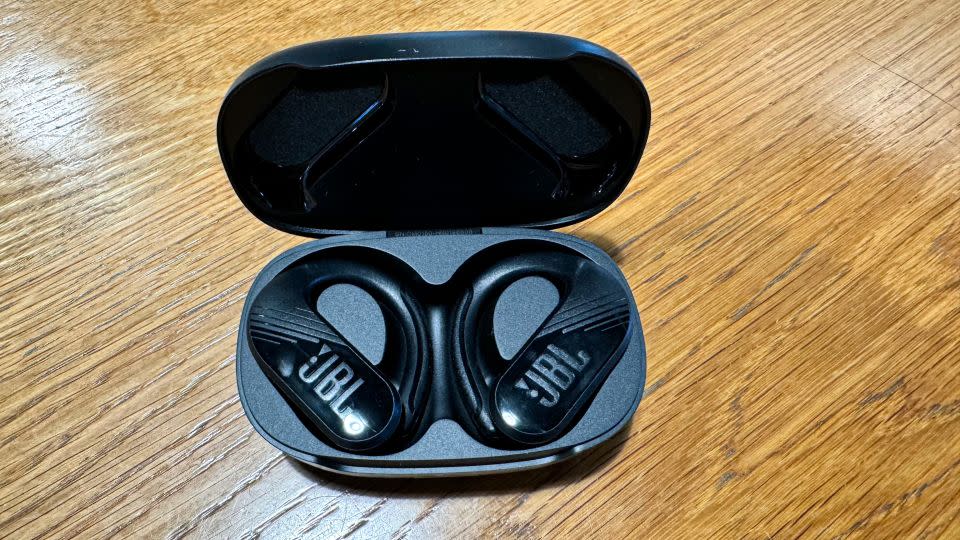
As the name suggests, these are meant to go the distance, and the buds boast up to 10 hours of battery power and an additional 40 in the case. That’s likely due to the lack of Active Noise Cancellation, which isn’t a necessity on the run. They do still feature JBL’s excellent Ambient Aware mode, which is more important when it comes to staying safe. The drawback for me was the size and weight of the Endurance Peak 3 earbuds. The speaker compartment is bulkier than any other headphone we tested, both in size and weight. A bendable ear hook helps keep them secure, but we didn’t love the sensation of wearing these for a two-hour run.
Note: The prices above reflect the retailers' listed price at the time of publication.
For more CNN news and newsletters create an account at CNN.com

